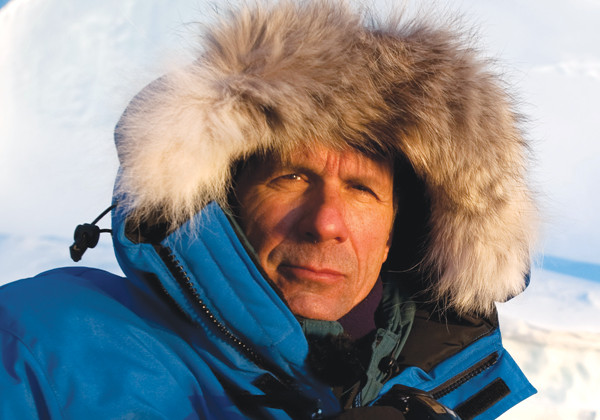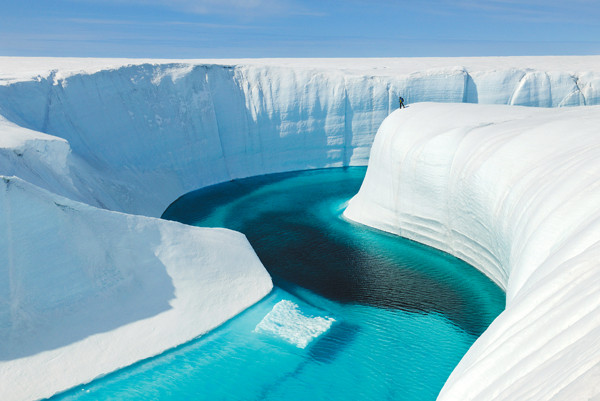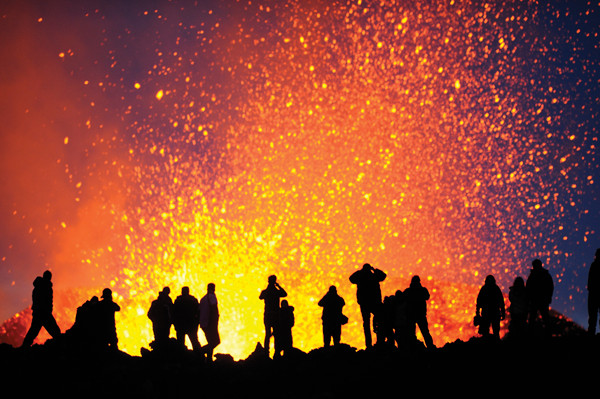
by Terri Cook Wednesday, December 17, 2014

"Chasing Ice," a 2012 documentary about photographer James Balog (above) and his quest to document Arctic ice retreat, won many awards, including one for cinematography at the Sundance Film Festival. Credit: courtesy of James Balog.
Photographer James Balog is known for his groundbreaking environmental photography that examines intersections of humans and nature. His work has appeared in publications ranging from National Geographic and Smithsonian to Audubon and The New Yorker. He has also authored eight books, including the recently released “Ice: Portraits of Vanishing Glaciers,” and he has been honored with dozens of awards, including the Heinz Award and PhotoMedia’s Person of the Year.
Balog’s interest in ice emerged from repeat assignments in Iceland where he was shocked by the rapid retreat of glaciers. To document the changes he was seeing, he put together a set of time-lapse cameras and assembled the Extreme Ice Survey (EIS), a team of science advisors and field personnel. The team gradually deployed more than 30 cameras across the Arctic to document the glaciers over the course of several years. The project is the subject of the documentary “Chasing Ice,” which last year won a cinematography award at the Sundance Film Festival and was nominated for an Academy Award for best song.
Before his career took that path, Balog was once a graduate student studying geomorphology and photographing his friends on climbing trips. He spoke recently with EARTH contributor Terri Cook, who was formerly EIS’s development director, about his journey from erstwhile geology graduate student taking odd carpentry jobs to pay the bills to a world-renowned photographer walking the red carpet.
TC: What was your research topic at the University of Colorado?
JB: I was mapping the tributaries of the Big Thompson River’s main stem [a tributary of the South Platte River with headwaters in Rocky Mountain National Park above Estes, Colo.,] trying to understand why some of them experienced enormous erosion during the 1976 flood, whereas others right next door had almost none. One of the things I was trying to understand was the flood’s recurrence interval, a subject that was hotly debated at the time. My advisor suggested looking at it from a geomorphology standpoint — figuring out what the volume of material removed from the basin during the flood could tell us about the frequency of recurrence.
At the time, NOAA was testing Doppler radar that could measure rainfall intensity. I found out at a seminar that they had Doppler maps for the Big Thompson River Canyon from the night of the flood [the deadliest flash flood in Colorado’s history]. I overlaid those on my erosion maps and tied together rainfall intensity with sediment mobilization. As far as I know, I was the first to put a real number on erosion in this region.

Birthday Canyon is one of many riddling the surface of the Greenland Ice Sheet, channeling increasing volumes of glacial meltwater to the sea. Credit: Courtesy of James Balog.
TC: When did you decide to switch from research to photography?
JB: I remember the exact night. It was the middle of May, and I was in my apartment, sitting by my fluorescent-lit desk with a stack of data punch cards in my hand. At that moment, I realized that this was what the future would hold in science. Suddenly, I knew that this was not the language in which I wanted to engage with nature; I had to do it with the camera. It was an insane idea because I knew nothing about photography, photojournalism or the process of making a life and a business out of it. I just had a youthful naïve brashness that it could be done.
TC: How did you get started?
JB: I started to read books about how to be a photographer. I was coming out of the climbing culture, and I thought the camera was a great excuse to go on adventures. I had in my head what guys did in National Geographic. I occasionally made some really beautiful shots on these climbing trips, and it was enough to give me the overwrought confidence that I knew what I was doing, not realizing how difficult it is to do it on command.
The first time I ever got a serious, paid assignment was an article on avalanche control for Smithsonian. That became a big photo essay, which led to the next thing, and the next. From the realization I had holding the punch cards to the Smithsonian essay was about three years.
TC: What is your creative process? Do you pick an issue you’d like to highlight and then photograph it, or do you decide on something you want to photograph and then build a series around it?
JB: It’s all of those things happening simultaneously. I have all these different things swirling around constantly in my head. I might have a theory about how I want to work on climate change, but I don’t know what that means. How do you photograph climate change? Is it penguins? Is it orcas? Is it polar travelers? No, it’s ice. Well then, what am I going to do about ice? More pretty sunrise pictures from the top of some mountain in Nepal? We’ve seen that picture for 50 years! So I keep trolling until experiences and circumstances coalesce, and I work my way into a project. I have also come to realize that the subject has to connect with something internal in me. There is deep, unconscious, neurotic necessity that’s behind all those series.

Balog has been working on a project on volcanoes since 1980. Credit: courtesy of James Balog.
TC: Are you always focused on the subject at hand, or do you sometimes go off on a lark?
JB: I’ve been working, off and on, on a volcano lark since 1980, when I went to photograph Mount St. Helens. A few years ago, I went all the way to Iceland for a one-day shoot. [Eyjafjallajökull] was erupting, and I just had to go, not knowing if I could even get out there. And by pure luck, I got the one crystal-clear night in about three months. I almost got killed, but it was a great night.
TC: How has your scientific training influenced your approach to photography and your career?
JB: The science has shaped my perception of what’s important. It helps me understand the core issues that are worth pursuing. It’s made me endlessly, infinitely curious about many things. I recently realized that almost everything I’ve done as an adult has been about the sculpture of landscapes — time and process, reshaping the world. Having that background in my head comes out of my training in geomorphology. It’s not something I consciously think about, but it’s there all the time.
TC: Does art have a role to play in disseminating scientific information to the public?
JB: What I’m constantly struck by is how much science knows about how the world works. Especially in the subject of climate change, there is a huge edifice of human knowledge that’s been built up, one study at a time. And the vast majority of that stays inside the hermetically sealed science community. Art is a translator that takes this gigantic edifice and helps to bring it out in a form that’s visible to the rest of society.
TC: Why are you fascinated by the concept of the Anthropocene, a time period defined by when the influence of humans becomes discernible in the geologic record? Do you think it should be officially designated by the International Union of Geological Sciences?
JB: Scientists will haggle about the term for a while because they have to anchor it in the specifics of geologic stratigraphy. Whether or not it survives that vetting process doesn’t matter to me. It’s a profound and basic notion that I think is an essential framing device for understanding who we are as a species, and where we, as organisms, stand at this point in history — the dominant agents of change on the planet. We’re changing the water, the plants, the animals, the ocean acidity, the sea level and the basic character of the air over our heads. As a photographer, I realize that this is a monumental piece of history unfolding before my eyes, and I want to photograph it.
TC: Although it wasn’t ultimately nominated, “Chasing Ice” was selected for the Academy Awards documentary shortlist. What was the Oscars process like?
JB: In a word, it was a whirlwind. The past year has been like in “The Wizard of Oz” when Dorothy gets sucked up inside the tornado, and there’s this crazy scene where everything is swirling around, and every once in a while, some figure emerges briefly out of the cloud. On the positive side, it’s been enormously gratifying to know that the project inspired so many people and has been part of shifting the social dialogue about this issue. I couldn’t have asked for more.
TC: Is there a single image you could show a skeptic to try to convince him or her that climate change is real and affecting our planet?
JB: No. It’s the combination of scientific context and the images; those two things have to come together, and you have to have an open enough mind to assemble the two halves. I think we’ve been enormously successful at inspiring those who already had an understanding of this issue, and educating and moving those who were seesawing between understanding and denying climate change. I don’t see it as a political issue or a partisan debate. It’s a universal issue with profound consequences for the health, economics and military security of every person on the planet.
© 2008-2021. All rights reserved. Any copying, redistribution or retransmission of any of the contents of this service without the expressed written permission of the American Geosciences Institute is expressly prohibited. Click here for all copyright requests.